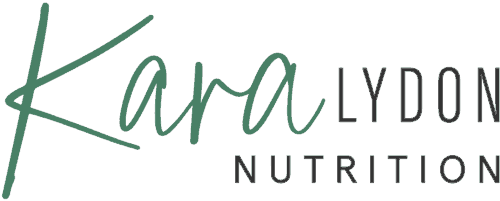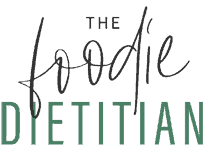New to intuitive eating but want to learn more? Our beginner’s guide to intuitive eating walks you through the 10 principles, the research, benefits, common myths and misconceptions, and how to get started on your own journey to healing your relationship with food.
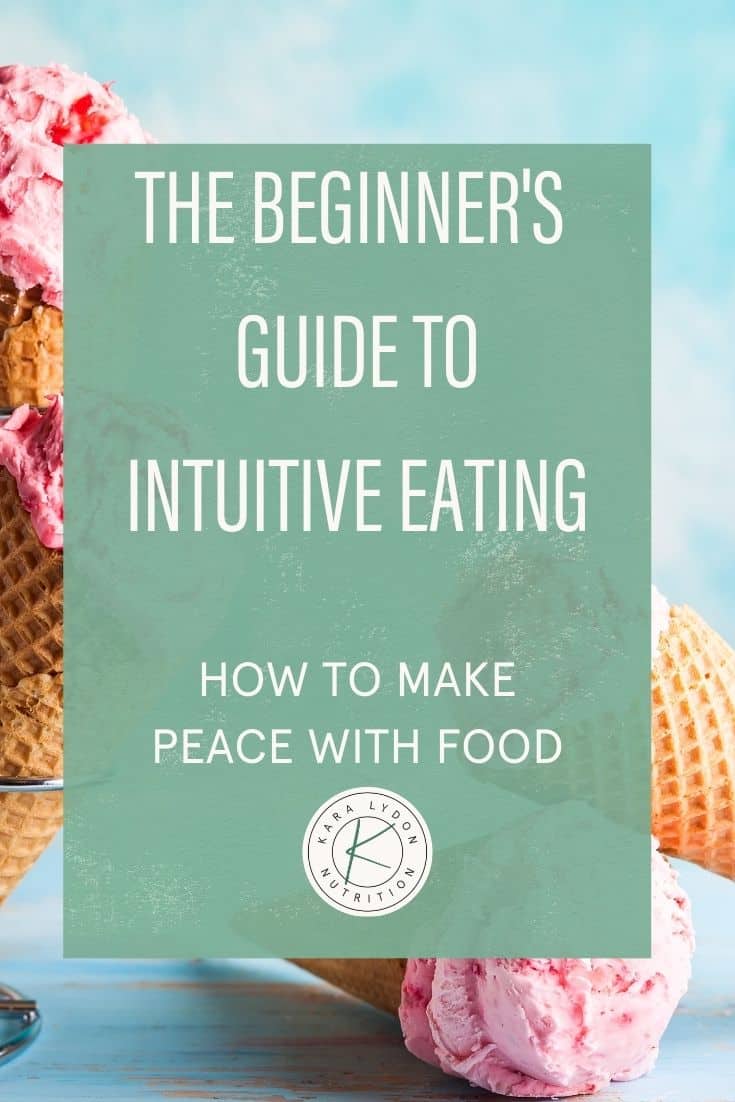
This blog post was written by Alix Eve Schram, MS, RD, and LDN at Kara Lydon Nutrition. Alix completed her Master’s in Clinical Nutrition at NYU. Alix is passionate about helping others find a more positive and peaceful relationship with food and body via Intuitive Eating. She feels strongly that there is no single image of health and that diets do not work. Alix specializes in Intuitive Eating, Eating Disorders and Disordered Eating, and body image work.
What Is Intuitive Eating?
Intuitive Eating (IE) is an evidence-based health approach created in 1995 by two dietitians, Elyse Resche and Evelyn Tribole. If you take anything away from this guide, let it be that intuitive eating is not a diet. In fact, it is often referred to as anti-diet. No foods are off limits. There are no rules on when, what, or how much to eat. A non-diet (or anti-diet) approach takes the focus away from judging success based on a number on the scale and places it on behaviors that promote health.
At its core, IE involves going back to the way we were naturally born to eat. When we were young, we ate when hungry and stopped when full, something we innately felt by listening to our body’s cues. We were not born measuring portions, tracking macros, or counting calories, and we did not pay attention to any external forces telling us what we should or shouldn’t do to be healthy (or thin, as diet culture would have it). The need to eat, or stop eating, was fully intuitive. Finding a way back to those internal cues is a large part of the intuitive eating practice. As a non-diet approach, IE involves meeting both physical and psychological needs, because mental health is equally important, and only you know what you need at any given time. You are the expert of your own body.
Per Resche and Tribole, intuitive eating is an empowerment tool; one you can use to escape from the dieting cycle and weight obsession to learn what it means and how it feels to truly be in touch with your body and heal your relationship with food.
If this sounds overwhelming, complicated, or simply not possible, that’s okay! Intuitive eating is a practice. It takes time to break down all the diet rules and emotions you may want to hold onto. Think about how long you’ve been dieting for or struggling with your relationship with food! You didn’t adopt these behaviors overnight and so the healing process of IE doesn’t happen overnight either. That’s why Resche and Tribole created the 10 Principles of Intuitive Eating, which are meant to guide you through recognizing and rejecting diet culture to coping with emotional eating to incorporating gentle nutrition, and more. We’ll take a look at those principles in depth later in this post.
Who Can Try Intuitive Eating?
Any human with a body can try intuitive eating. Seriously. There are no qualifying factors or prerequisites to fulfill in order to fit the IE bill. You don’t have to have an issue with dieting or weight loss or struggle with various disordered eating habits. If you do suffer from a diagnosed eating disorder, though, working with an eating disorder dietitian who is also trained in intuitive eating can be very helpful. If you have food allergies, dietary restrictions, or medical conditions, they can be honored and held within the IE framework.
I’ve previously covered two specific questions I receive on this topic on my blog:
- Can athletes practice intuitive eating? The answer: yes.
- Can intuitive eating concepts work for someone with IBS? The answer: also yes.
What are the Benefits of Intuitive Eating?
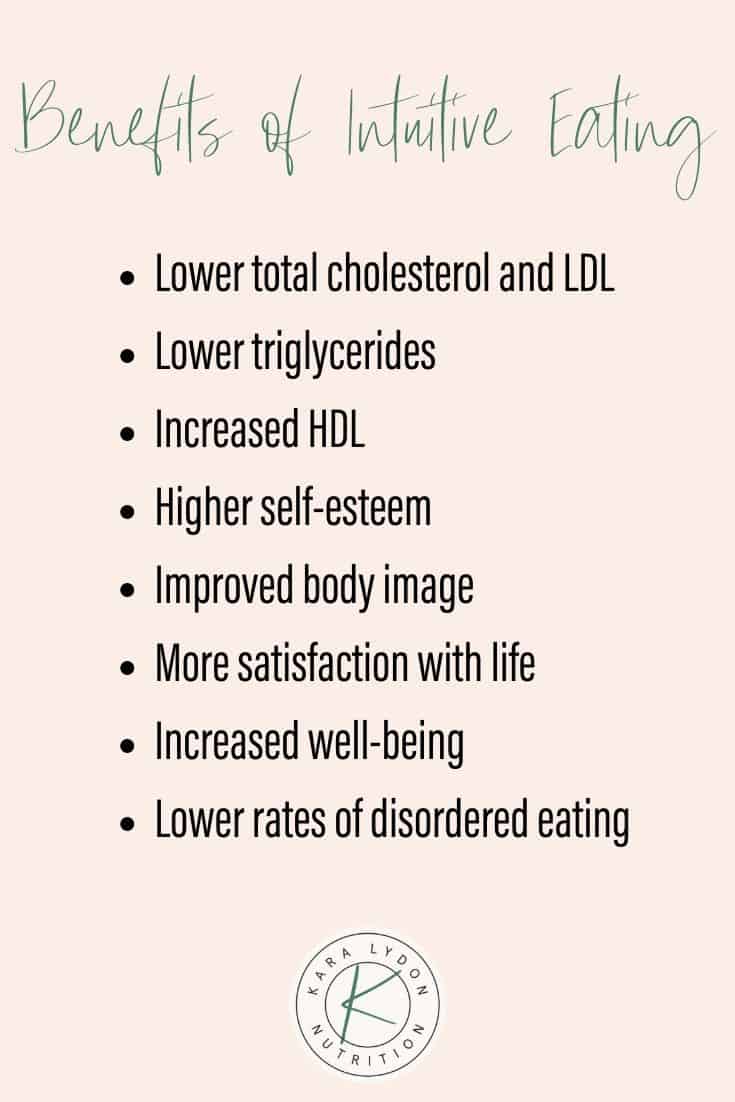
There are over 100 research studies – and more ongoing – that look at the benefits of intuitive eating. Positive health benefits with significant association include:
- Lower total cholesterol and LDL
- Lower triglycerides
- Increased HDL
- High self-esteem
- Improved body image
- More satisfaction with life
- Increased well-being
- Lower rates of disordered eating and eating disorders
Why Is Intuitive Eating Popular?
Let’s begin with a brief description of diet culture. Even if you’re not on a specific diet, it does not mean you aren’t tied up in the diet culture world. It’s easy to get lost in this system of beliefs: lost in the idea that thin equals healthy, that weight loss grants you higher status in the world, that certain ways of eating are bad and others are good, and that it’s okay to stigmatize those who don’t match one picture of health. Yes, that’s a big sentence, yet it’s still hard to recognize all the insidious ways that diet culture sneaks into our lives.
Recently, more research around the harms of dieting – and intentional weight loss – have reached the mainstream. It’s been shown that weight cycling (losing weight and gaining it back) has a higher risk of death than maintaining a higher weight. And, those with an “overweight” BMI (the BMI is a story for another time) have the lowest risk of death and chronic disease across all BMIs. Lastly, research shows that weight stigma can actually cause more harm than simply being in a larger body. So, why do we still diet? Why do we still covet thin bodies and stigmatize others? Diet culture.
Here’s the thing, apart from the harm caused, the bigger picture is this: diets don’t work. You might say “hey, but I’ve lost weight on a diet,” and that is probably true. However, it’s also probably true that you weren’t able to keep the weight off. So, did the diet really work? No! The research overwhelmingly supports the fact that diets are not sustainable. Research also shows that two-thirds of dieters regain more weight than they lost on the diet. And, any health benefits achieved in the short-term are equally not long-lasting. In fact, as noted above, diets can actually cause negative health outcomes.
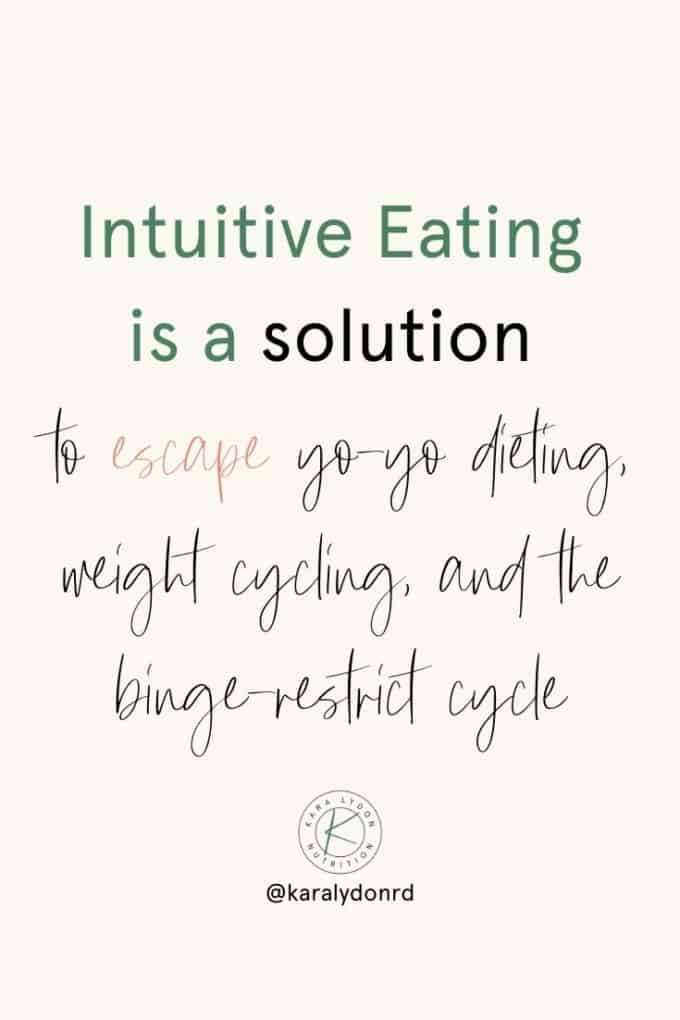
It’s likely you’ve dieted before (or tried a diet in disguise like a “lifestyle program”), maybe even tried a number of different diets. As I mentioned above, it’s also likely you lost weight. But, the diet was so difficult to sustain that you stopped following it, gained the weight back, and maybe developed some disordered eating habits along the way. After a little break, you thought maybe a different diet would be better, and you start the process again. This is called yo-yo dieting, in which you are consistently going on and off diets, often resulting in weight-cycling (aka losing and regaining weight over and over), which can be detrimental to both physical and mental health.
Dieting also typically involves intense restrictions, often on both the amount you eat and the types of food you eat. When we don’t get enough calories, the brain releases a chemical called Neuropeptide Y (NPY), which makes you crave carbs. So, after a period of restricting, our survival mechanism kicks in, triggering a binge. Clinically, a binge means: “eating, in a discrete period of time, an amount of food that is definitely larger than what most people would eat in a similar period of time under similar circumstances.” There is also typically a feeling of loss of control associated. Afterwards, you might feel extreme guilt and shame, and vow to “do better” (aka restrict better) the next day. This is the binge-restrict cycle, which many dieters – and non-dieters- struggle with. At this point, many feel they’ve hit “diet rock bottom” and can’t take it anymore.
This is where intuitive eating comes into play. Intuitive eating is a solution to escape yo-yo dieting, weight cycling, and the binge-restrict cycle. In fact, the first principle of intuitive eating is to reject diet culture – to reject the idea that the next diet will be successful and to reject that weight is the end-all-be-all of health. IE is the counter to the damaging and stressful behaviors dieting demands. Instead, IE helps you get back to how you were born to eat, to listen to your body, to let go of the external rules, and to find lasting peace with food.
The 10 Principles of Intuitive Eating
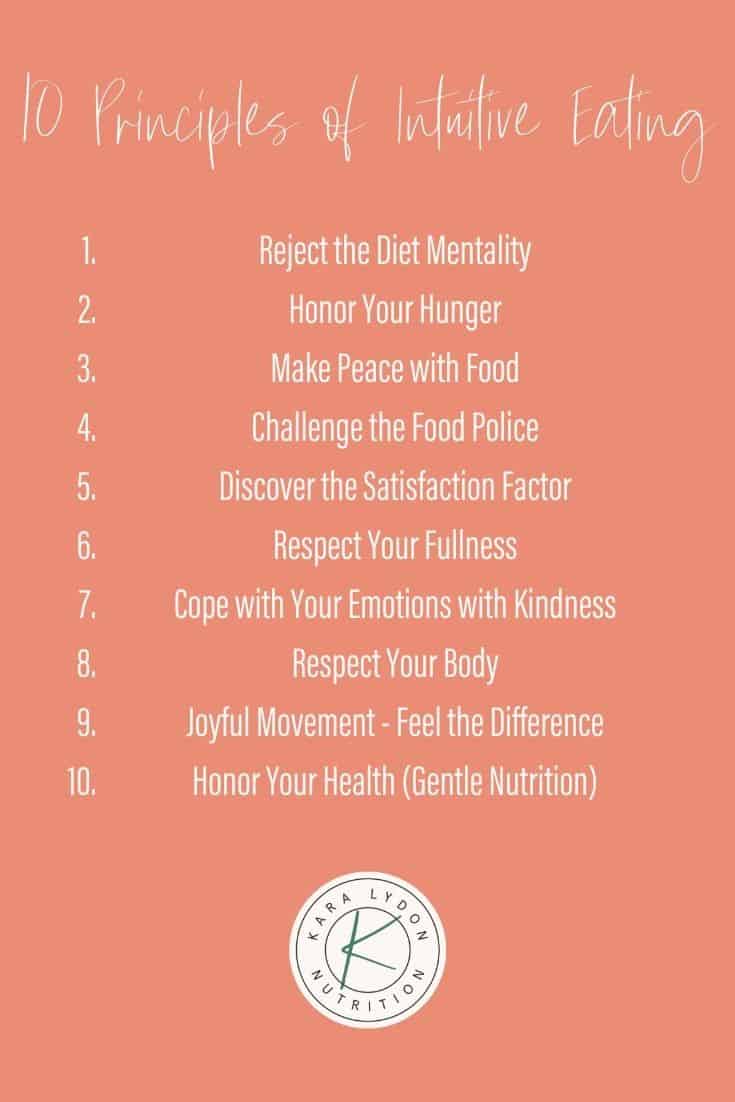
As mentioned, Resche and Tribole created ten guiding principles of intuitive eating. Each has its own chapter in their book and is equally important to the one before and after. The intention is that you would move through each principle, spending time to understand its importance in the journey and working to put it into practice. There are no rules that you need to follow these principles in order – IE is not a linear process. Although, gentle nutrition is intentionally the last principle because if you haven’t yet rejected diet culture or made peace with food, it will be hard not to turn gentle nutrition principles into another diet or set of rules.
1. Reject the Diet Mentality
Dieting, the drive to lose weight, and the idea that thin is better are ingrained within us from a young age. How many diets have you tried? Have they worked? For how long? Did it make you feel happier, inside and out? How long did those feelings last? Chances are they “worked” for a period of time before they stopped working. Diets are the problem, not you. You did not fail your diet, or fail to become a better person by not losing enough weight. Diets don’t work, no matter how they are marketed to you. Work on rejecting the idea that dieting is the answer. Unfollow social media accounts that promote diets, weight loss, or diet culture. Toss your diet-related cookbooks. Surround yourself with positive, weight-inclusive messaging about food and body.
2. Honor Your Hunger
In diet culture, being hungry is praised. The hungrier you are, the “better” you are, the more “willpower” you have. This is an unnatural way of being for every human – hunger is a biological process and we need food to survive. Going back to a previous point, hunger is a key factor in the binge-restrict cycle. The longer you restrict, the hungrier you become. Our bodies don’t like being hungry, and eventually our primal instinct to survive will kick in, leading to intense cravings and an increased chance of bingeing and feeling out of control with food. In order to become more intuitive around food, you have to honor your hunger and all its nuances. Work on learning your body’s hunger signs, and feed it what it needs.
3. Make Peace with Food
I often hear my clients say “I love ice cream, but I can’t keep it in the house because I’ll eat the entire thing.” In these cases, ice cream is viewed as a “bad” food that should be enjoyed sparingly. The thing is, the more you tell yourself you can’t eat a specific food, the more intensely you’ll want it. Research shows that the pleasure centers in our brain actually light up more when introduced to a food that has been off-limits. Cravings will increase until they hit a peak, and you do find yourself eating the entire pint or more. Learn to give yourself unconditional permission to eat. If you can have ice cream anytime you want, the deprivation mindset is gone, and with it the intense cravings and the bingeing.
If the first thing that comes to mind on the topic of off-limits food is anything carbs, you might find this free download extra helpful! It’s got 5 steps that will guide you through what carbs are, why we need them, and how to stop letting them have all the power. Grab the download here!
4. Challenge the Food Police
Diets love to label foods as good or bad, which leads us to believe we – personally – are good or bad depending on what we eat. The fourth principle of intuitive eating encourages you to say no to those unreasonable rules. Say no to the food police yelling at you that the food you’re eating is “bad” and that you should feel guilt or shame for eating it.
5. Discover the Satisfaction Factor
Food is more than just fuel. In order to feel truly full, you also need to feel satisfied. This can only happen when you allow yourself to eat what you actually want. Think back to when you wanted pasta at an Italian restaurant but ordered the fish. You may have been full, but were you satisfied? Probably not, because it wasn’t what your body OR mind was craving. Grab the tips I use to find your satisfaction factor here.
6. Respect Your Fullness
Just as you need to honor your hunger, you must also respect your fullness. Pay attention while eating any meal or snack and ask yourself how you’re feeling. Are you still hungry? Does your stomach feel full? You might be familiar with the discomfort of being overly full but there are many more nuances to fullness than that stuffed feeling. Learning hunger and fullness cues is a process; it will take time to tune into your body on this level.
7. Cope with Your Emotions with Kindness
First, it’s important to recognize that emotional eating is okay, and in fact, a normal coping response. It’s also important to develop tools other than eating when emotions run high so that food becomes one of many coping skills in your toolbox for you to choose from. You may also experience a lot of difficult emotions around food, but you can begin to work with those emotions by viewing them with kindness and self-compassion. If this feels like a foreign idea, check out this post on how to practice self-compassion, in which I go over what self-compassion means, why it matters, and how you can practice it.
8. Respect Your Body
Every human body is different, and even if we all ate and exercised in the same way, they’d STILL be different. Resche and Tribole use this analogy: if you’re a size 8 shoe, it would be impossible (and uncomfortable!) to squeeze into a size 5. The same goes for your body. All bodies deserve equal respect and dignity, not criticism and contempt. You don’t have to love your body – but respecting it is different – it means showing up for your body, taking care of it, and treating it with kindness.
9. Joyful Movement – Feel the Difference
I’ve written a number of posts on this principle, as exercise is so frequently co-opted by diet culture and is also often overlooked when it comes to disordered eating or eating disorders. Movement is beneficial for our physical and mental health, but over-exercise can be quite dangerous. Shift the focus from burning calories to how it feels to move. Choose exercise that makes you feel good, happy, energized, positive, or even relaxed (like light stretching). If something feels bad, don’t do it! Need more on the difference between joyful movement and overexercise? I also wrote about why I stopped taking the stairs, and more recently, went in depth on what fitspiration is and its inherent harms.
10. Honor Your Health (Gentle Nutrition)
One of the misconceptions about intuitive eating is that you will just eat whatever you want, whenever you want it. Principle ten debunks this theory – nutrition is an essential part of IE and overall health. Gentle nutrition is about making choices that will promote health and honor what will make you feel best, mentally and physically. Including fruits and vegetables every day is beneficial, but not having them at one meal, or day, or even week, will not make or break your health. With this principle of IE, we’re taking a flexible approach to nutrition, one that emphasizes balance and variety. Nutrition is not about rigid rules or numbers – this is why I don’t include nutrition information on my recipes! Grab more tips in my post: how to practice gentle nutrition.
What Intuitive Eating Is Not: Myths and Misconceptions
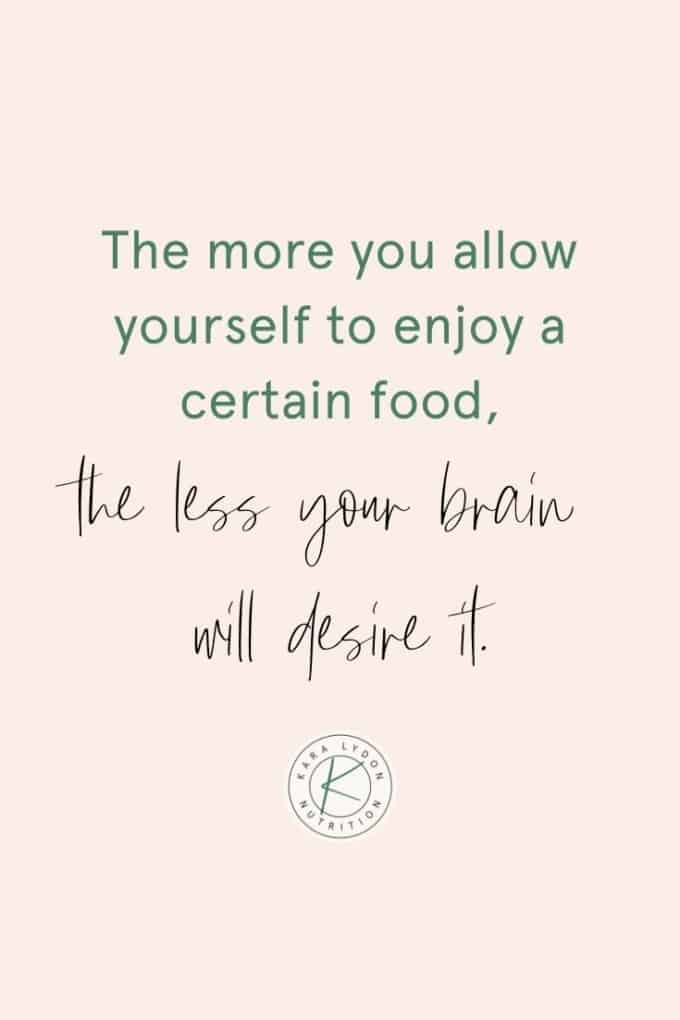
Intuitive Eating Means Eating Pizza and Candy All the Time
If you were to read principle three – unconditional permission to eat – without diving any deeper, this might be the assumption you’d make. And, while you might eat more pizza and candy (or whatever it is you crave) in the beginning of your intuitive eating journey, this honeymoon phase will not last forever.
In fact, the more you allow yourself to enjoy a certain food, the less your brain will desire it. The food is no longer scarce, a novelty, or off-limits. If you know you can have that food whenever you want, the cravings will be less frequent or intense, and even more, you’ll be less likely to feel out of control around that food when you do have it. When you are able to listen to what your body wants and learn what makes your body feel best, you might find yourself reaching for more nutrient-dense options.
Intuitive Eating Is Just About Hunger and Fullness
Listening to hunger and fullness cues are just two of the ten principles of intuitive eating; they are one part of the larger whole. Following a diet strictly based on hunger and fullness cues is exactly that: a diet. Once you apply black and white rules to what or when you eat, diet culture is back in the picture. Hunger and fullness cues are extremely nuanced and fall on a spectrum. Listening to those cues does not mean only eating when they are abundantly clear. In fact, there are many times it makes sense to eat when not hungry or when full. If this is something you’re struggling with, be sure to check out my post on Are you on the Hunger Fullness Diet?
Intuitive Eating Results in Weight Loss
You might lose weight. You might stay the same weight. You might gain weight. Focusing on weight loss while practicing intuitive eating is, well, unintuitive. Interoceptive awareness, which is understanding and listening to the body’s internal cues, becomes less possible if you’re still thinking about external cues, i.e. calories and the number on the scale. It also makes finding a peaceful relationship with food difficult, as there will likely still be foods you restrict because you fear they will make you gain weight. Can you still want to lose weight and practice intuitive eating? Yes, but it’s important to understand how it might undermine your IE efforts, the “why” behind that goal, as well as put more thought into markers of success that don’t involve the scale.
Proponents of intuitive eating commonly practice from the Health at Every Size™ paradigm (HAES), which promotes size-acceptance, body diversity and respect, and that all bodies should have equal access to healthcare. There’s so much more to say on this topic, but for now, you can read more about the HAES approach on their website: Association for Size Diversity and Health.
And if an intuitive eating coach or provider promises you weight loss, run. Run far, far away, and find another clinician. Because they will not be practicing and teaching intuitive eating in the way it was intended.
Intuitive Eating Is the Same Thing As Mindful Eating
While sharing some similarities, mindful eating encompasses only one small part of intuitive eating. Mindful eating does involve satisfaction, nourishment, and hunger/satiety cues, but it’s generally marketed and practiced as a strategy for weight loss. With recommendations like chew 20 times, eat small bites, and choose modest portions, mindful eating quickly gets tied up in diet culture. It skips over important IE principles listed above such as rejecting the diet mentality, respecting your body, joyful movement, gentle nutrition, and emotional eating. Practicing mindfulness is an essential tool in intuitive eating, but it is not the only thing that intuitive eating represents.
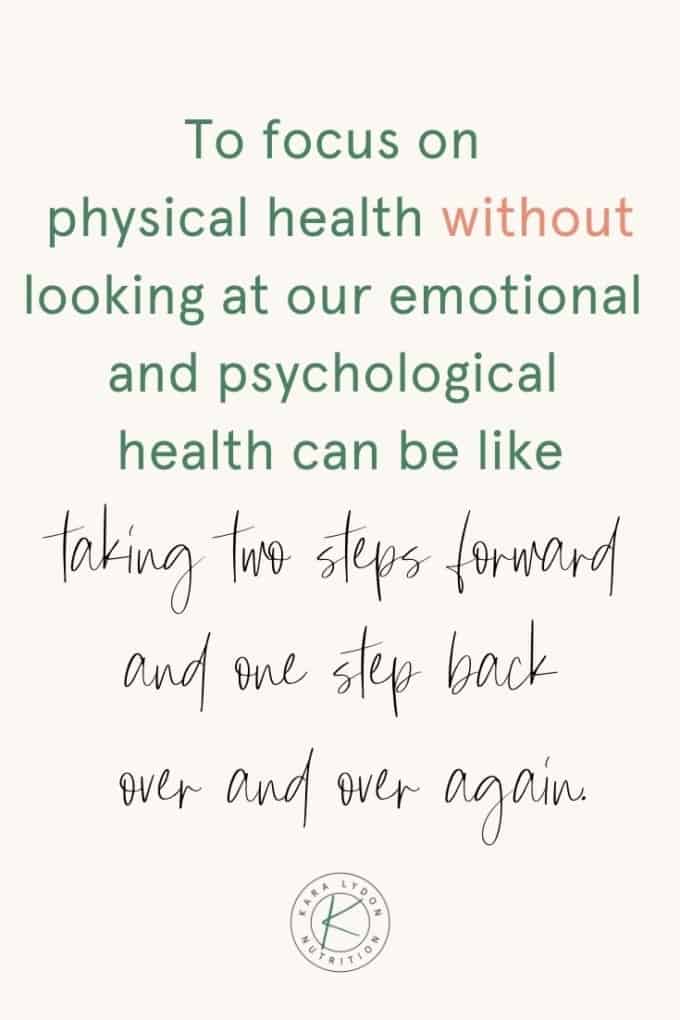
Intuitive Eating Is Anti-Health
There is a difference between not focusing on weight loss as a goal and being anti-health. Health is absolutely the goal with intuitive eating, but it looks at health from a broader scope. Mental health is so often overlooked, but is intertwined with physical health. To focus on physical health without looking at our emotional and psychological health can be like taking two steps forward and one step back over and over again. Intuitive eating does not ignore nutrition (see: Principle 10); it takes the whole self into account and encourages health-promoting behaviors that do not only center around what we eat.
How to Get Started on your Intuitive Eating Journey
Intuitive eating can be challenging to attempt alone, so I highly recommend working with a Certified Intuitive Eating Counselor or a practice who specializes in IE, like my practice. You’ll also want to dive into the literature, starting with the Intuitive Eating book (fourth edition) by Resche and Tribole. If you want more, check out this list of my go-to intuitive eating books that even an IE expert will find helpful.
Want More Support for Your IE Journey? Check out all of our IE blog posts below!
- What Do Intuitive Eating and The Universe Have in Common?
- How Intuitive Eating Changed My Life
- How to Raise an Intuitive Eater
- How I Became an Intuitive Eating Dietitian
- Is Intuitive Eating Appropriate for Athletes?
- Intuitive Eating and IBS-D
- How to Make Your Social Media More Body Positive
- Are You on the Hunger Fullness Diet?
- What Does Unconditional Permission to Eat Really Mean?
- Feeling Full vs. Feeling Satisfied
- 3 Ways to Experience More Food Satisfaction
- How to Practice Self-Compassion
- What’s the difference between healthy movement and over-exercise?
- Why I Decided to Stop Taking the Stairs
- What Does Fitspo Actually Mean? Everything You Need to Know About Fitspiration
- Why I Don’t Include the Nutrition Information for My Recipes
- How to Practice Gentle Nutrition in Intuitive Eating
- Can you Lose Weight with Intuitive Eating?
- Nourish Your Namaste: How Nutrition and Yoga Can Support Digestion, Immunity, Energy & Relaxation is here!
